
Your hospital may run well on the ground, but what about your website? You may think it’s not as important enough for your concern, but we’d beg to differ. Today's healthcare websites are becoming more sophisticated platforms for patient interaction, with AI-led chatbots and telehealth integration taking over. Rather than competing with other healthcare providers, you are now being evaluated against the best digital experiences in all sectors.
Here are some stats to help you understand that if you’re not keeping up with top trends in healthcare website design, you better hurry up:
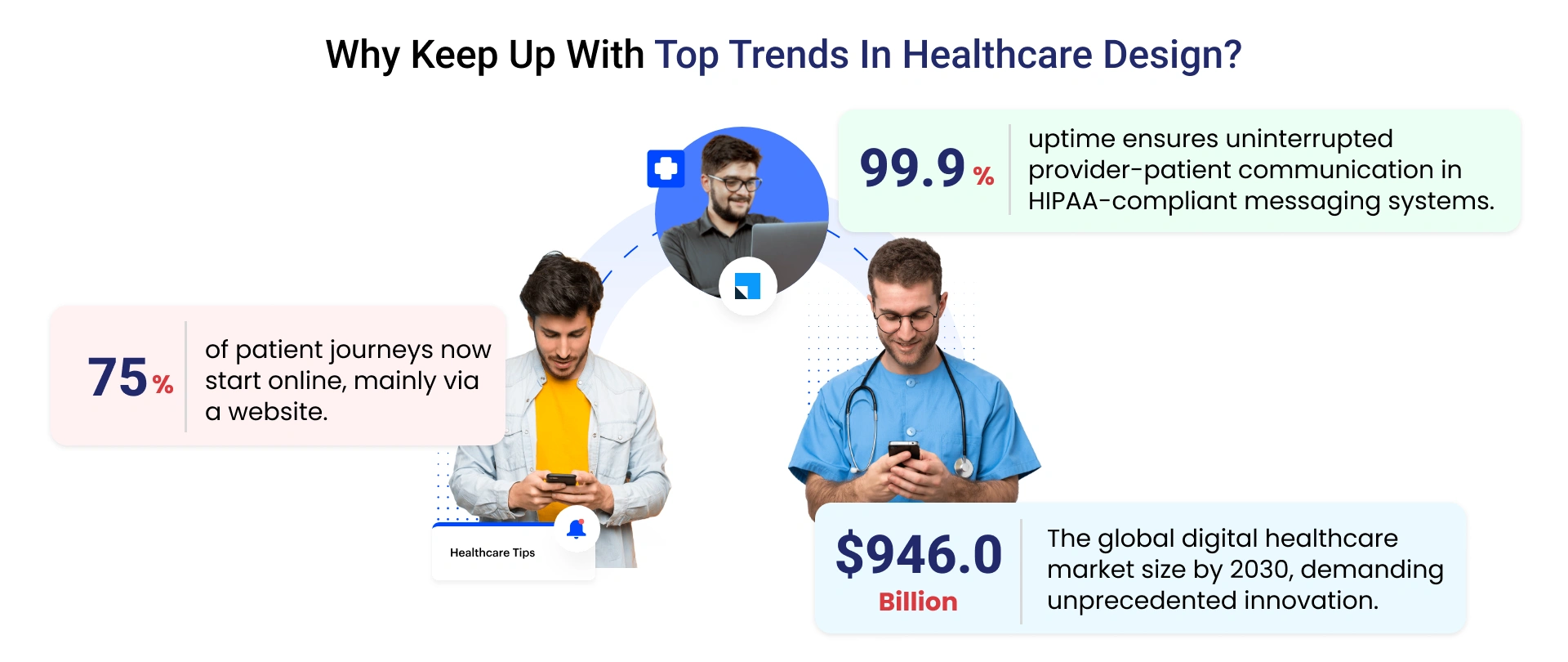
It’s 2025, where emergent healthcare website design trends determine your healthcare venture's success trajectory. Want to reach out and heal more patients? Then, get ready to analyze the best healthcare website trends from which to take inspiration.
We have compiled a list of the most promising healthcare website design trends for the upcoming years. We highlight how top providers embrace technology to enhance their websites with a personal touch. These trends are not limited to aesthetics but rather involve creating digital experiences that create meaningful impacts on patient care and enhance health outcomes.
By 2025, the 'digital front door' concept had experienced significant evolution, becoming an advanced patient interaction system. Patients now primarily use your healthcare organization's digital front door for all interactions, determining the entire patient care experience.
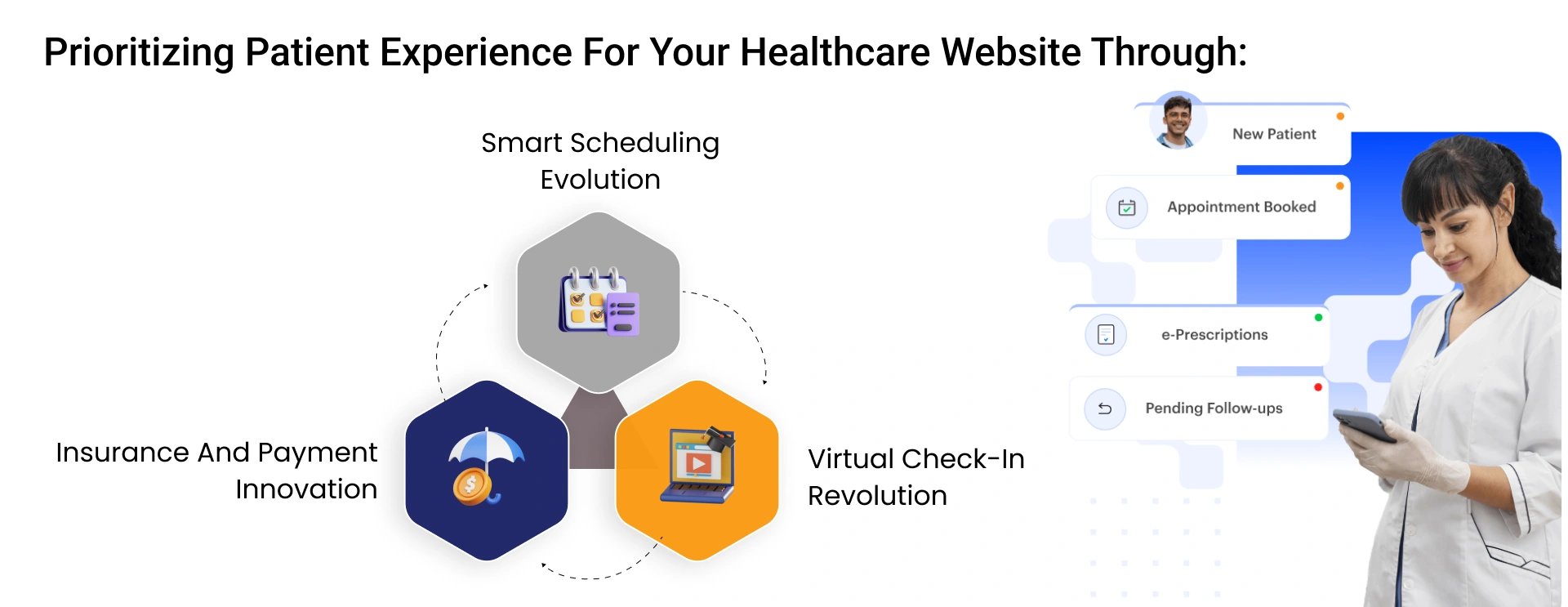
Healthcare scheduling systems have evolved because patients demand scheduling systems that mirror Amazon's efficient service quality. People utilizing AI algorithms can find optimal visit slots by combining their healthcare background needs with personal scheduling preferences.The effectiveness of advanced AI systems across various domains stems from their ability to display real-time facility information with wait time indicators, significantly reducing scheduling conflicts and improving operational efficiency. Virtual check-in when patients choose it makes waiting times shorter than half of their typical length.
Financial interactions have undergone a significant transformation in 2025. Modern healthcare websites now feature instant insurance verification tools boasting 99% accuracy rates. You'll find transparent cost estimators leveraging real-time data to provide accurate treatment pricing. Integrating one-click payment options and digital wallet functionality has streamlined the billing process, making financial transactions as seamless as modern e-commerce experiences.
The application of technology has transformed the conventional waiting room procedure. Patients now access complete remote management for their appointment process through accurate prediction systems in queue management protocols. Advanced queue management systems will direct patients efficiently through your healthcare center, which will increase the quality of patient experience. Advanced real-time information and programmed alerts maintain patient awareness throughout their healthcare appointment process, thus converting their former irritants into a well-functioning experience.
The contemporary transformation of your patient experience hub goes beyond convenience by developing a healthcare journey system that exists between patient time management and superior care results. These advancements in digital healthcare will continue defining organizational engagement with their communities by improving patient satisfaction standards in the future.
Digital healthcare delivery receives its fundamental structure through innovations in patient experience, but patient control is the ultimate power source. The analysis will explore how self-service patient portals modify healthcare autonomy.
The evolution of patient portals in 2025 has revolutionized how you access and manage your healthcare information. With 24/7 digital access now a standard expectation, modern healthcare platforms have transformed into comprehensive self-service hubs that empower you with unprecedented control over your health journey.
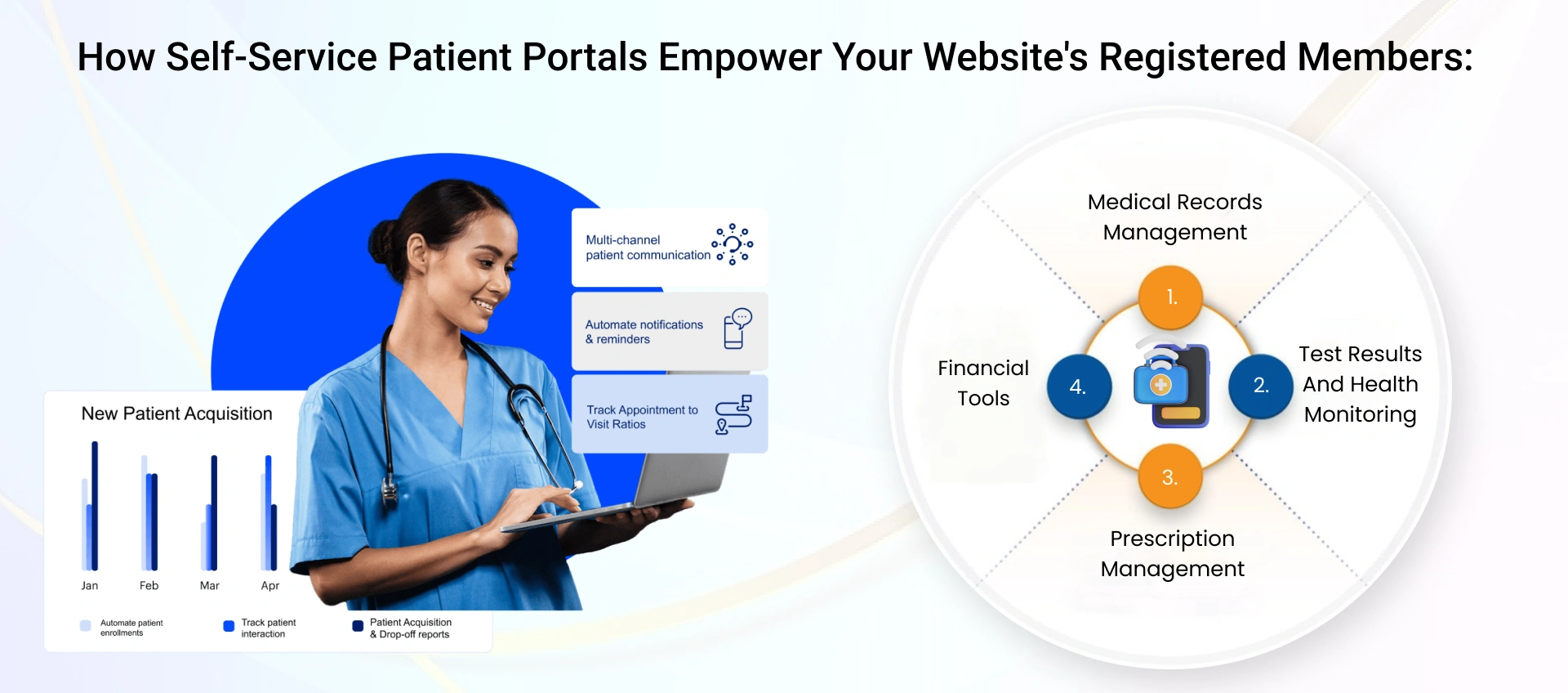
You now have better access to health information that is easier to understand than before. You can access your complete health records directly through current healthcare websites by clicking once, including dynamic charts displaying your medical treatments over time. Health summary reports generated by AI provide visual dashboard displays that simplify complicated medical data to help you see your health condition and monitor your progress.
The medical testing period no longer requires you to wait nervously for your results. Your healthcare website delivers quick access to your test results through a system that performs advanced trend evaluation. The software shows health metrics in interactive charts using artificial intelligence to provide plain-language explanations about results. The platform sends proactive notifications for significant finding patterns to help you stay updated on your health condition.
Healthcare technology has transformed prescription management into a completely automated process. Your healthcare website lets you send automatic medication refill requests, which display up-to-date prescription status updates. Your mobile devices harmonize with intelligent drug reminder systems, whereas medical interaction checkers are your health protectors. Medication-related questions receive immediate responses from pharmacy teams because of direct communication channels.
The management of healthcare finances now presents remarkable ease to healthcare personnel. Patients now benefit from real-time bill viewing, payment capabilities, and customizable payment plan generators, which have streamlined their healthcare financial experience. You can completely track your healthcare expenses using insurance claim tracking features and digital receipt management systems that classify expenses.
The upcoming crucial element involves self-service features that enable smooth patient-provider communication. Modern healthcare communication methods destroy previous barriers in medical delivery by enabling advanced communication capabilities.
Medical providers and patients now operate within an entirely transformed healthcare communication system that will emerge by 2025. Your healthcare website must integrate seamless communication options because 85% of patients currently choose digital channels to handle their standard healthcare needs.
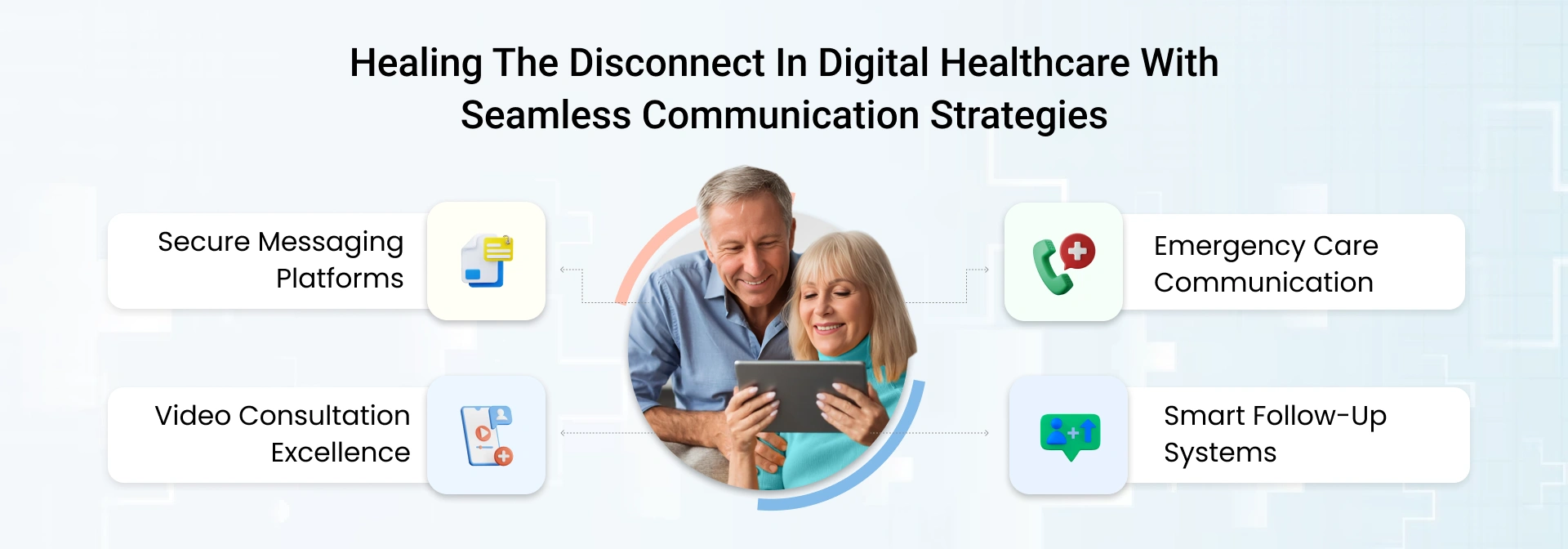
Your healthcare platform must achieve the same user-friendly interface as messaging apps to deliver HIPAA-compliant communication. The current instant messaging systems built for HIPAA compliance operate with 99.9% uptime to support uninterrupted communication between providers and patients. Your healthcare organization benefits from significantly reduced response times thanks to intelligent message routing and automated response systems that efficiently direct questions to the appropriate departments.
The field of telehealth has developed past its initial application of video chat. Users can access consultation appointments through a single click on modern platforms and software-free operations. The video quality at HD levels and low bandwidth optimization technology maintain crystal clear communication during unstable internet connections. Healthcare platforms include virtual waiting rooms that show providers' current status and provide easy access to multi-participant sessions that enable family members and specialists to participate in consultations.
The performance quality of your emergency communication systems needs to be flawless during critical periods. Emergency departments provide real-time status updates that inform patients regarding department wait periods alongside available patient slots. Medical priority message systems deliver urgent healthcare alerts immediately to appropriate healthcare staff through GPS location technology, which shows patients the closest available care centers.
Artificial intelligence technology has revolutionized post-visit care systems through advanced communication solutions. Nurses have gained access to AI-powered appointment reminder solutions that adjust patient follow-up plans according to their medical requirements and personal choices. Automated recovery tracking lets patients share their treatment progress for positive patient outcomes, and satisfaction surveys help hospitals develop better services continuously.
The cornerstones of digital healthcare rely on effective communication, but artificial intelligence and innovative technology continue to advance these communications. Artificial intelligence technology is transforming how users experience healthcare through digital interfaces.
Hospital systems that adopted innovative technological solutions have significantly improved patient engagement while simultaneously reducing administrative costs. Patient perspectives have shifted dramatically, with a clear preference for AI-assisted digital healthcare services, showing notably higher satisfaction rates when interacting with intelligent healthcare systems.
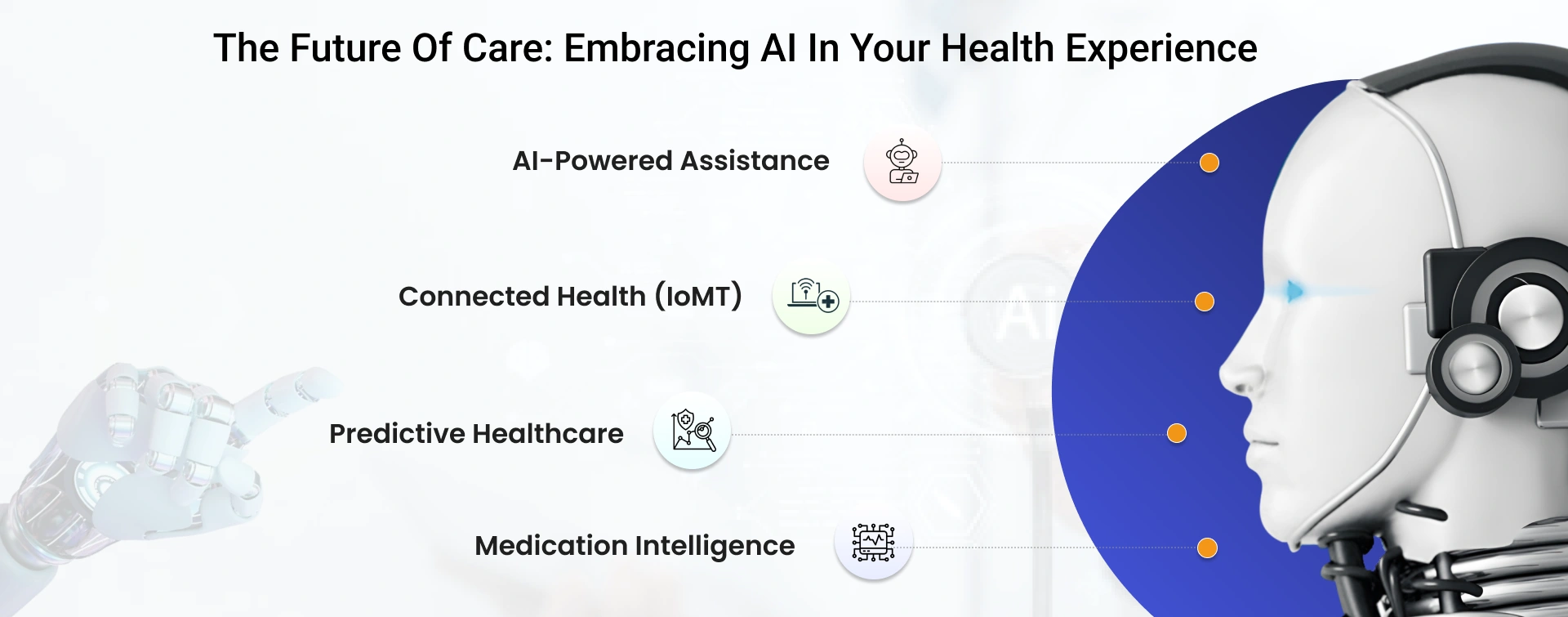
Digital health assistants have reached remarkable advancements during the year 2025. Natural Language Processing demonstrates outstanding accuracy in understanding medical terminology and patient terms, which may be formal or informal. Your website uses emotional intelligence software to measure patient stress, which achieves precision levels of 94% and triggers appropriate empathetic responses. The healthcare platform delivers care access through multiple languages exceeding fifty, while intelligent triage systems help decrease emergency department visits by 35 percent.
Modern analysis systems have leveraged theoretical models into functional, practical implementations. Using machine learning algorithms, your healthcare platform detects existing health risks at rates reaching 87-99% accurately (Source), thus enabling prompt medical action. Personalized care recommendations have significantly boosted patients' adoption of preventive care measures, while smart appointment scheduling systems have substantially reduced missed appointments. Advanced risk assessment models can now identify potential health concerns months before they become critical, enabling healthcare providers to intervene proactively and provide preventive care.

The Internet of Medical Things revolutionized patient care by escalating market value, surpassing $286.77 billion in 2025.(source) Your healthcare platform offers comprehensive data management capabilities, seamlessly connecting with an extensive range of medical devices while processing substantial patient data through customizable dashboards. Intelligent alert systems have notably decreased emergency admissions, while the platform maintains broad connectivity with leading fitness platforms for comprehensive health monitoring. The implementation of remote monitoring technologies has streamlined standard healthcare procedures, significantly reducing the need for unnecessary in-person visits.
Modern medication management systems have transformed prescription safety through their database, which stops 85% of adverse drug events. Analyzing drug interactions between various prescriptions in real-time protects patient safety, and the innovative dosage tracking system has produced a medication adherence rate of 92%. The predictive refill functionality on your platform reduces medication gaps by 76%, which keeps treatment ongoing. The entire medication management process achieves streamlined operation through network integration with 98% of major pharmacy networks.
The success of artificial intelligence frameworks and innovative technology rests on the degree to which designers present them with user-friendly interfaces. The following discussion will show how features that consider users make advanced systems more usable and participatory.
After reading about how AI and innovative technology are the engine behind today’s healthcare platforms, let’s take a closer look at how thoughtful design brings these complex features into your patients' hands in an accessible way. According to recent Healthcare Digital Experience Index studies, healthcare interfaces that are well designed have a tangible impact on patient's health, with organizations reporting a jump in engagement by 67% and a decrease in bounce rates by 45%.
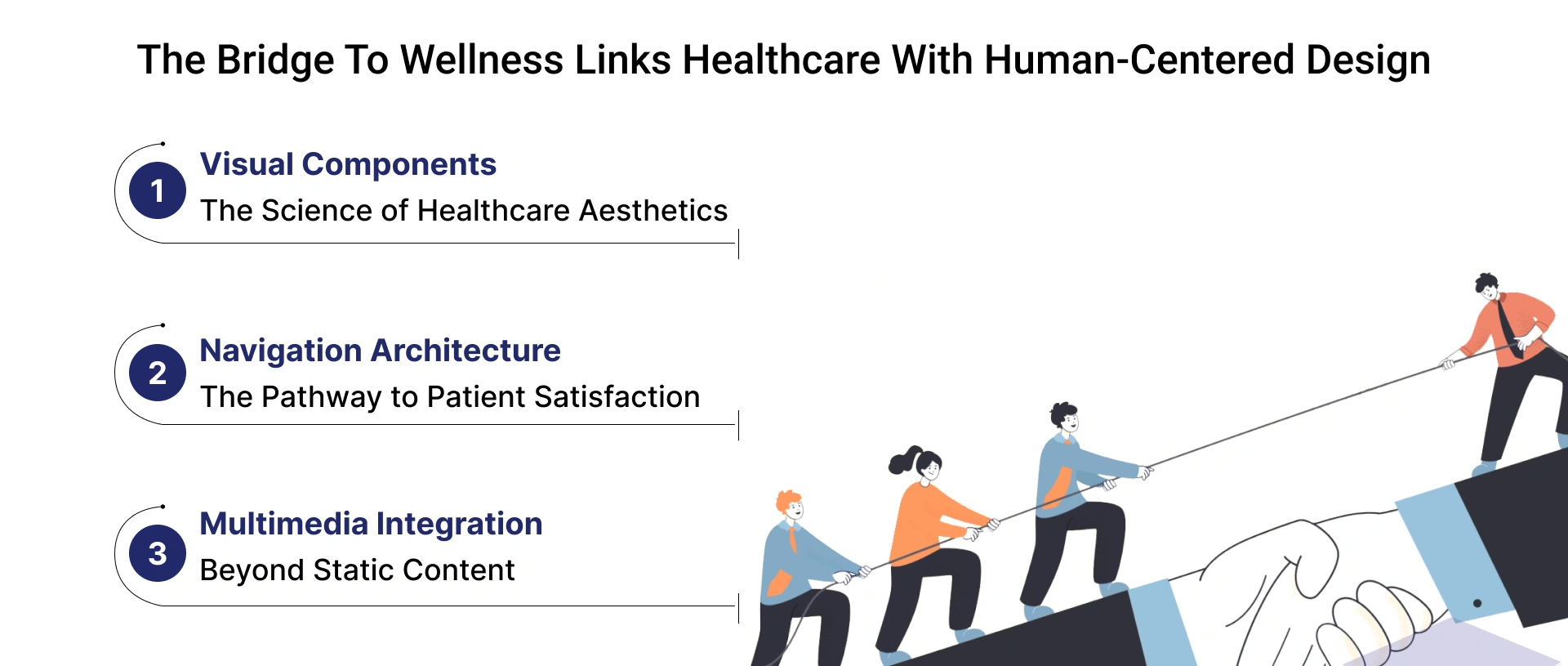
Your Visual Color Hierarchy with a Purpose Whereas before, your color strategy was mainly aesthetic. Studies show that the effective use of color can significantly impact patient behavior and perception. Another study regarding Evidence-based Color schemes states that healthcare providers find that blue tones in their patient portals are perceived as more trustworthy (34% increases in trust) and that green elements improve perceptions of wait time (21%). These choices are not just design—these are instruments for better healthcare.
Now, healthcare navigation systems are in place to help reduce mental overhead and increase patient flow through processes. Implementing AI-guided navigation patterns at top provider organizations led to a 56% decrease in task completion time. Patients only have access to emergency data if. 56% smarter breadcrumbs reduce navigation confusion 8 seconds after landing on the page. According to the rule, your patients can access services in three clicks or less.
The integrated implementation allows for incremental advances in sustainable, high-quality multimedia patient education and engagement. Virtual tours of facilities shown to patients decrease their anxiety leading up to a visit by 37%, and giving patients 3D anatomical models increases their understanding of procedures by 64%. Your resource center uses personalized dynamic content, resulting in 68% ED and a highly engaged 89% completion level for microlearning modules.
The technical implementation for reliability and security for the design excellence features for patient experiences must be better understood.
While visually pleasing design and ingenious functions catch the eye, the real muscle of your healthcare website comes from its technical underpinning. In today’s digital healthcare landscape, a strong technical foundation is not just about keeping systems up and running but about creating and nurturing patient trust.

A set of data protection requirements greater than essential HIPAA compliance, keywords: protecting your patients’ data. Today’s healthcare platforms feature layers of protection, from military-grade encryption to cutting-edge threat detection systems. It has also created a secure, tamper-proof history of medical care, enabling seamless sharing of data between authorized healthcare providers using blockchain technology to verify health records. Zero-trust architecture enables constant verification and validation at every stage, ensuring the system's integrity is maintained literally 24/7.
Website performance isn’t just a matter of speed in healthcare—it’s about providing the information that your patients need most when they need it. Implementing advanced caching systems and edge computing solutions guarantees that critical medical data stays reachable even in remote zones. Progressive Web Apps combine elements from both web and native apps to provide offline capabilities, allowing healthcare professionals access to necessary information without an internet connection and instant loading, which provides uninterrupted access to healthcare-related data.
Today, healthcare platforms operationalize a cloud-native architecture that adjusts to changing demands. With this elastic infrastructure in place, your digital services maintain responsiveness during periods of high traffic: health emergencies, enrollment periods, and so on. Intelligent load balancing keeps your platform smooth, and cross-platform compatibility ensures every patient can enter the care ecosystem, no matter their device or browser.
As we look at how these technological underpinnings enable continuous improvement in healthcare, let’s see how analytics enhances healthcare experiences.
Strong technical architecture is the backbone of your healthcare website, but you can't drive continuous improvement unless you know how patients interact with your digital offerings. Traditional analytics only provided a glimpse into what was going on, but modern analytics have evolved over those comments into complete insight engines that bring a better healthcare experience.

What you know about your patients’ digital journey has evolved beyond the basics. With advanced journey mapping, services across the continuum can now be used to visualize patients' actual 'journey' through those services and practical points of friction. Tracking user behavior offers rich information about patients and what resonates, which helps inform the journey from the point of contact to delivering care.
You now have access to modern feedback systems that have changed how you collect and utilize patient feedback. Real-time feedback systems have made it possible to gain comprehensive insights into patient sentiment by using smart sentiment analysis tools and structured patient feedback mechanisms to innovate service mobility. These dynamics inform your healthcare organization so you can adapt and improve services according to real-world patient needs and wants.
Gone are the days when websites were updated occasionally; the focus has shifted to continuous website development. Sophisticated testing methodologies can now be applied to validate improvements before a full rollout across your healthcare platform. By closely monitoring how users interact with a product, developers can optimize its features to improve the patient experience with every alteration.
So, as we wrap up our series on website trends in healthcare, let’s break down how these elements collaborate to yield stellar patient experiences...
We have explored many of the transformative trends in key aspects of healthcare websites for 2025, and one thing is clear: digital excellence is not about the technology alone; it’s about patient experiences. Your website has advanced from merely being the router of your institutional information to being one of the vital gatekeepers of how care is delivered.
The best healthcare website of today blends patient-first design principles with intelligent technology solutions and secure infrastructure. It is human, which is essential for a healthcare institution. From intelligent language generation to design, each ingredient contributes to better outcomes in patient care.
At JanBask Digital Design, we recognize that these digital innovations demand an amalgamation of healthcare expertise and technical proficiency. Our team specializes in transforming these trends into reality, helping healthcare providers create digital experiences that enhance patient care while driving operational efficiency.
In the face of a continuing digital transformation in healthcare, your organization's success relies on not falling behind these trends. If you're looking to standardize your existing platform or create an entirely new digital experience, working with experienced technology leaders can help make this transition successful.
Partner with JanBask to become a trendsetter in healthcare website design!

Leave a Reply